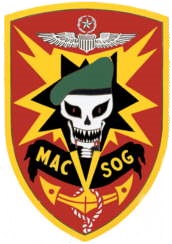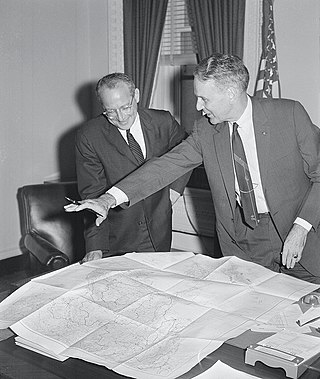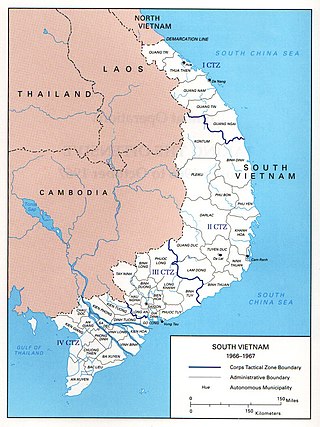| |||||
| Decades: | |||||
|---|---|---|---|---|---|
| See also: | |||||
The following lists events that happened during 1961 in Vietnam .
| |||||
| Decades: | |||||
|---|---|---|---|---|---|
| See also: | |||||
The following lists events that happened during 1961 in Vietnam .

The People's Army of Vietnam (PAVN), officially the Vietnam People's Army, also recognized as the Vietnamese Army or the People's Army, is the national military force of the Socialist Republic of Vietnam and the armed wing of the ruling Communist Party of Vietnam (CPV). The PAVN is a part of the Vietnam People's Armed Forces and includes: Ground Force, Navy, Air Force, Border Guard and Coast Guard. Vietnam does not have a separate Ground Force or Army service. All ground troops, army corps, military districts and special forces belong to the Ministry of National Defence, directly under the command of the CPV Central Military Commission, the Minister of National Defence, and the General Staff of the Vietnam People's Army. The military flag of the PAVN is the National flag of the Socialist Republic of Vietnam defaced with the motto Quyết thắng added in yellow at the top left.

The Vietnam War was a conflict in Vietnam, Laos, and Cambodia from 1 November 1955 to the fall of Saigon on 30 April 1975. It was the second of the Indochina Wars and was a major conflict of the Cold War. While the war was officially fought between North Vietnam and South Vietnam, the north was supported by the Soviet Union, China, and other communist states, while the south was supported by the United States and other anti-communist allies, making the war a proxy war between the United States and the Soviet Union. It lasted almost 20 years, with direct U.S. military involvement ending in 1973. The conflict also spilled over into neighboring states, exacerbating the Laotian Civil War and the Cambodian Civil War, which ended with all three countries officially becoming communist states by 1976.

South Vietnam, officially the Republic of Vietnam was a country in Southeast Asia that existed from 1955 to 1975, the period when the southern portion of Vietnam was a member of the Western Bloc during part of the Cold War after the 1954 division of Vietnam. It first received international recognition in 1949 as the State of Vietnam within the French Union, with its capital at Saigon, before becoming a republic in 1955. South Vietnam was bordered by North Vietnam to the north, Laos to the northwest, Cambodia to the southwest, and Thailand across the Gulf of Thailand to the southwest. Its sovereignty was recognized by the United States and 87 other nations, though it failed to gain admission into the United Nations as a result of a Soviet veto in 1957. It was succeeded by the Republic of South Vietnam in 1975. In 1976, the Republic of South Vietnam and North Vietnam merged to form the Socialist Republic of Vietnam.

The Viet Cong was an epithet and umbrella term to call the communist-driven armed movement and united front organization in South Vietnam, Laos and Cambodia. Formally organized as and led by the National Liberation Front of South Vietnam, it fought under the direction of North Vietnam against the South Vietnamese and United States governments during the Vietnam War. The organization had both guerrilla and regular army units, as well as a network of cadres who organized and mobilized peasants in the territory the Viet Cong controlled. During the war, communist fighters and some anti-war activists claimed that the Viet Cong was an insurgency indigenous to the South that representing the legitimate rights for people in South Vietnam, while the U.S. and South Vietnamese governments portrayed the group as a tool of North Vietnam. It was later conceded by the modern Vietnamese communist leadership that the movement was actually under the North Vietnamese political and military leadership, aiming to unify Vietnam under a single banner.

The Battle of Đồng Xoài was a major battle fought during the Vietnam War as part of the Viet Cong (VC) Summer Offensive of 1965. It took place in Phước Long Province, South Vietnam, between June 9 and 13, 1965.

Military Assistance Command, Vietnam – Studies and Observations Group (MACV-SOG) was a highly classified, multi-service United States special operations unit which conducted covert unconventional warfare operations before and during the Vietnam War.

The 1975 spring offensive, officially known as the general offensive and uprising of spring 1975, was the final North Vietnamese campaign in the Vietnam War that led to the capitulation of Republic of Vietnam. After the initial success capturing Phước Long Province, the North Vietnamese leadership increased the scope of the People's Army of Vietnam's (PAVN) offensive and captured and held the key Central Highlands city of Buôn Ma Thuột between 10 and 18 March. These operations were intended to be preparatory to launching a general offensive in 1976.
United States involvement in the Vietnam War began shortly after the end of World War II in Asia, first in an extremely limited capacity and escalating over a period of 20 years. The U.S. military presence peaked in April 1969, with 543,000 American combat troops stationed in Vietnam. By the conclusion of the United States's involvement in 1973, over 3.1 million Americans had been stationed in Vietnam.

The Taylor-Rostow Report was a report prepared in November 1961 on the situation in Vietnam in relation to Vietcong operations in South Vietnam. The report was written by General Maxwell Taylor, military representative to President John F. Kennedy, and Deputy National Security Advisor W.W. Rostow. Kennedy sent Taylor and Rostow to Vietnam in October 1961 to assess the deterioration of South Vietnam’s military position and the government's morale. The report called for improved training of Army of the Republic of Vietnam (ARVN) troops, an infusion of American personnel into the South Vietnamese government and army, greater use of helicopters in counterinsurgency missions against North Vietnamese communists, consideration of bombing the North, and the commitment of 6,000-8,000 U.S. combat troops to Vietnam, albeit initially in a logistical role. The document was significant in that it seriously escalated the Kennedy Administration's commitment to Vietnam. It was also seen historically as having misdiagnosed the root of the Vietnam conflict as primarily a military rather than a political problem.

CIA activities in Laos started in the 1950s. In 1959, U.S. Special Operations Forces began to train some Laotian soldiers in unconventional warfare techniques as early as the fall of 1959 under the code name "Erawan". Under this code name, General Vang Pao, who served the royal Lao family, recruited and trained his Hmong and Iu-Mien soldiers. The Hmong and Iu-Mien were targeted as allies after President John F. Kennedy, who refused to send more American soldiers to battle in Southeast Asia, took office. Instead, he called the CIA to use its tribal forces in Laos and "make every possible effort to launch guerrilla operations in North Vietnam with its Asian recruits." General Vang Pao then recruited and trained his Hmong soldiers to ally with the CIA and fight against North Vietnam. The CIA itself claims that the CIA air operations in Laos from 1955 to 1974 were the "largest paramilitary operations ever undertaken by the CIA."
CIA activities in Vietnam were operations conducted by the Central Intelligence Agency in Vietnam from the 1950s to the late 1960s, before and during the Vietnam War. After the 1954 Geneva Conference, North Vietnam was controlled by communist forces under Ho Chi Minh's leadership. South Vietnam, with the assistance of the U.S., was anti-communist under Ngo Dinh Diem's leadership. The economic and military aid supplied by the U.S. to South Vietnam continued until the 1974. The CIA participated in both the political and military aspect of the wars in Indochina. The CIA provided suggestions for political platforms, supported candidates, used agency resources to refute electoral fraud charges, manipulated the certification of election results by the South Vietnamese National Assembly, and instituted the Phoenix Program. It worked particularly closely with the ethnic minority Montagnards, Hmong, and Khmer. There are 174 National Intelligence Estimates dealing with Vietnam, issued by the CIA after coordination with the U.S. intelligence community.

The 1959 to 1963 phase of the Vietnam War started after the North Vietnamese had made a firm decision to commit to a military intervention in the guerrilla war in the South Vietnam, a buildup phase began, between the 1959 North Vietnamese decision and the Gulf of Tonkin Incident, which led to a major US escalation of its involvement. Vietnamese communists saw this as a second phase of their revolution, the US now substituting for the French.

During the Cold War in the 1960s, the United States and South Vietnam began a period of gradual escalation and direct intervention referred to as the "Americanization" of joint warfare in South Vietnam during the Vietnam War. At the start of the decade, United States aid to South Vietnam consisted largely of supplies with approximately 900 military observers and trainers. After the assassination of both Ngo Dinh Diem and John F. Kennedy close to the end of 1963 and Gulf of Tonkin incident in 1964 and amid continuing political instability in the South, the Lyndon Johnson Administration made a policy commitment to safeguard the South Vietnamese regime directly. The American military forces and other anti-communist SEATO countries increased their support, sending large scale combat forces into South Vietnam; at its height in 1969, slightly more than 400,000 American troops were deployed. The People's Army of Vietnam and the allied Viet Cong fought back, keeping to countryside strongholds while the anti-communist allied forces tended to control the cities. The most notable conflict of this era was the 1968 Tet Offensive, a widespread campaign by the communist forces to attack across all of South Vietnam; while the offensive was largely repelled, it was a strategic success in seeding doubt as to the long-term viability of the South Vietnamese state. This phase of the war lasted until the election of Richard Nixon and the change of U.S. policy to Vietnamization, or ending the direct involvement and phased withdrawal of U.S. combat troops and giving the main combat role back to the South Vietnamese military.

The year 1961 saw a new American president, John F. Kennedy, attempt to cope with a deteriorating military and political situation in South Vietnam. The Viet Cong (VC) with assistance from North Vietnam made substantial gains in controlling much of the rural population of South Vietnam. Kennedy expanded military aid to the government of President Ngô Đình Diệm, increased the number of U.S. military advisors in South Vietnam, and reduced the pressure that had been exerted on Diệm during the Eisenhower Administration to reform his government and broaden his political base.

The defeat of the South Vietnamese Army of the Republic of Vietnam (ARVN) in a battle in January set off a furious debate in the United States on the progress being made in the war against the Viet Cong (VC) in South Vietnam. Assessments of the war flowing into the higher levels of the U.S. government in Washington, D.C. were wildly inconsistent, some citing an early victory over the VC, others a rapidly deteriorating military situation. Some senior U.S. military officers and White House officials were optimistic; civilians of the Department of State and the Central Intelligence Agency (CIA), junior military officers, and the media were decidedly less so. Near the end of the year, U.S. leaders became more pessimistic about progress in the war.

South Vietnam was in political chaos during much of the year, as generals competed for power and Buddhists protested against the government. The Viet Cong (VC) communist guerrillas expanded their operations and defeated the South Vietnamese Army of the Republic of Vietnam (ARVN) in many battles. North Vietnam made a definitive judgement in January to assist the VC insurgency with men and material. In November, North Vietnam ordered the People's Army of Vietnam (PAVN) to infiltrate units into South Vietnam and undertake joint military operations with the VC.

The Viet Cong (VC) insurgency expanded in South Vietnam in 1962. U.S. military personnel flew combat missions and accompanied South Vietnamese soldiers in ground operations to find and defeat the insurgents. Secrecy was the official U.S. policy concerning the extent of U.S. military involvement in South Vietnam. The commander of Military Assistance Command, Vietnam (MACV), General Paul D. Harkins, projected optimism that progress was being made in the war, but that optimism was refuted by the concerns expressed by a large number of more junior officers and civilians. Several prominent magazines, newspapers and politicians in the U.S. questioned the military strategy the U.S. was pursuing in support of the South Vietnamese government of President Ngô Đình Diệm. Diệm created the Strategic Hamlet Program as his top priority to defeat the VC. The program intended to cluster South Vietnam's rural dwellers into defended villages where they would be provided with government social services.

In 1958, the upswing in violence against the government of South Vietnam continued, much of which was committed by the communist-dominated insurgents now called the Viet Cong. In South Vietnam, President Ngo Dinh Diem appeared to be firmly in power, although many American officials expressed concern about the repressive nature of his regime. The United States continued to finance most of the budget of the government of South Vietnam. North Vietnam continued to campaign for reunification with the South while focusing on its internal economic development, but pressure from hard-pressed communists in the South was forcing the North to contemplate a more active military role in overthrowing the Diem government.

Operation Lam Son II was a combined United States and South Vietnamese military and public relations operation in the village of Tân Phước Khánh, Tân Uyên District, in III Corps around 40 km north of the capital Saigon staged from June 2 to June 5, 1966, during the Vietnam War. It was done in order to simultaneously win public support for the government of South Vietnam by holding a village fair and providing social services while simultaneously screening the congregated area to arrest and remove Viet Cong guerrillas operating in the area.

The Liberation Army of South Vietnam was an irregular military force established by the Workers' Party of Vietnam in 1961 in South Vietnam as the armed wing of the Viet Cong. In 1962, the People's Revolutionary Party of South Vietnam separated from the Workers' Party of Vietnam in terms of external appearance, openly directing the Liberation Army's military. Politically, the South Vietnamese Liberation Army was under the direction of the National Front for the Liberation of South Vietnam and the Provisional Revolutionary Government of the Republic of South Vietnam. The military forces from the North to the South of Vietnam, although collectively known as the Liberation Army of South Vietnam, still use the unit names, military badges and War flag of the Vietnam People's Army.